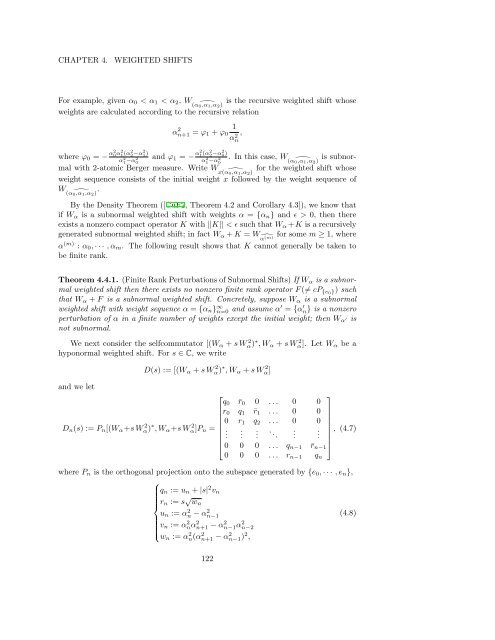Woo Young Lee Lecture Notes on Operator Theory
Woo Young Lee Lecture Notes on Operator Theory
Woo Young Lee Lecture Notes on Operator Theory
You also want an ePaper? Increase the reach of your titles
YUMPU automatically turns print PDFs into web optimized ePapers that Google loves.
CHAPTER 4.<br />
WEIGHTED SHIFTS<br />
For example, given α 0 < α 1 < α 2 , W (α0,α ̂ is the recursive weighted shift whose<br />
1,α 2)<br />
weights are calculated according to the recursive relati<strong>on</strong><br />
αn+1 2 1<br />
= φ 1 + φ 0<br />
αn<br />
2 ,<br />
where φ 0 = − α2 0 α2 1 (α2 2 −α2 1 ) and φ<br />
α 2 1 = − α2 1 (α2 2 −α2 0 ) . In this case, W<br />
1 −α2 0<br />
α 2 1 −α2 ̂<br />
0<br />
(α0<br />
is subnormal<br />
with 2-atomic Berger measure. Write W x(α0 ̂ for the weighted shift whose<br />
,α 1 ,α 2 )<br />
,α 1 ,α 2 )<br />
weight sequence c<strong>on</strong>sists of the initial weight x followed by the weight sequence of<br />
W<br />
.<br />
(α0,α ̂ 1,α 2)<br />
By the Density Theorem ([CuF2, Theorem 4.2 and Corollary 4.3]), we know that<br />
if W α is a subnormal weighted shift with weights α = {α n } and ϵ > 0, then there<br />
exists a n<strong>on</strong>zero compact operator K with ||K|| < ϵ such that W α +K is a recursively<br />
generated subnormal weighted shift; in fact W α + K = W for some m ≥ 1, where<br />
̂α(m)<br />
α (m) : α 0 , · · · , α m . The following result shows that K cannot generally be taken to<br />
be finite rank.<br />
Theorem 4.4.1. (Finite Rank Perturbati<strong>on</strong>s of Subnormal Shifts) If W α is a subnormal<br />
weighted shift then there exists no n<strong>on</strong>zero finite rank operator F (≠ cP {e0 }) such<br />
that W α + F is a subnormal weighted shift. C<strong>on</strong>cretely, suppose W α is a subnormal<br />
weighted shift with weight sequence α = {α n } ∞ n=0 and assume α ′ = {α n} ′ is a n<strong>on</strong>zero<br />
perturbati<strong>on</strong> of α in a finite number of weights except the initial weight; then W α ′ is<br />
not subnormal.<br />
We next c<strong>on</strong>sider the selfcommutator [(W α + s W 2 α) ∗ , W α + s W 2 α]. Let W α be a<br />
hyp<strong>on</strong>ormal weighted shift. For s ∈ C, we write<br />
D(s) := [(W α + s W 2 α) ∗ , W α + s W 2 α]<br />
and we let<br />
⎡<br />
⎤<br />
q 0 ¯r 0 0 . . . 0 0<br />
r 0 q 1 ¯r 1 . . . 0 0<br />
D n (s) := P n [(W α +s Wα) 2 ∗ , W α +s Wα]P 2 0 r 1 q 2 . . . 0 0<br />
n =<br />
⎢ .<br />
.<br />
.<br />
. .. . . , (4.7)<br />
⎥<br />
⎣ 0 0 0 . . . q n−1 ¯r n−1<br />
⎦<br />
0 0 0 . . . r n−1 q n<br />
where P n is the orthog<strong>on</strong>al projecti<strong>on</strong> <strong>on</strong>to the subspace generated by {e 0 , · · · , e n },<br />
⎧<br />
q n := u n + |s| 2 v n<br />
⎪⎨ r n := s √ w n<br />
u n := αn 2 − αn−1<br />
2 (4.8)<br />
v n := αnα 2 n+1 2 − αn−1α 2 n−2<br />
2 ⎪⎩<br />
w n := αn(α 2 n+1 2 − αn−1) 2 2 ,<br />
122













